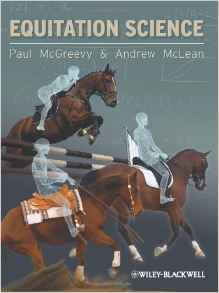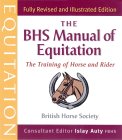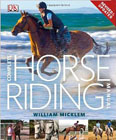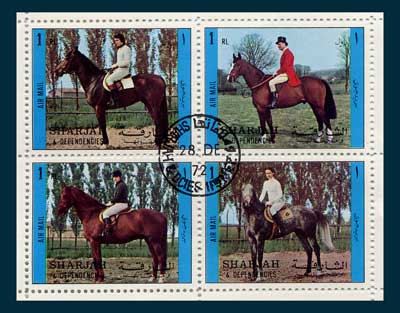Horses: Riding, training and behaviour
If you want to buy a book, clicking on the book cover will take you directly to that book on the Amazon.co.uk web site.
See also:
News and Research: Horses, Ponies and Donkeys
Article

Equitation Science
‘Equitation Science’ is an approach to training horses based on insights into learning from a school of psychology called ‘behaviourism’. The authors explain basic concepts such as classical and operant conditioning, and ‘habituation’, or getting horses used to something so that it no longer spooks them. This explanation is a bit heavy-going unless you already have a background in psychology, and if you have, you may find it tedious.
The authors’ goal is to assess practices using both scientific and ethical criteria, with the idea that both horses and riders will benefit from a more efficient and humane approach. In some ways, this works, and most horse people will find some insights in ‘Equitation Science’, especially in the section on clicker training. However, scientific research often discovers what many experienced people in a field have known for a long time, so academic scientists need some humility. Furthermore, new research papers are appearing all the time, so any attempt at pinning down a ‘scientific approach’ needs constant updating. Since this book came out, academic scientists have published some interesting work on how horses try to tell us what they want. Experienced owners know that horses can do this – we only have to listen.
It‘s also difficult to write in general terms when each horse and rider forms a unique partnership. Horses used to being ridden by different people tend to be a lot less responsive than those who have built up a partnership with one rider with whom they communicate well. Styles and techniques can differ according to what the rider’s goals are. How well a rider uses the seat to send messages to the horse depends on both experience and coordination. How a horse responds to use of reins depends on the horse’s previous experience, and the rider’s skill. The authors perhaps needed to be warier of generalizing quite so much. However, despite its limitations, ‘Equitation Science’ is a thought-provoking read, with a lot to offer experienced riders.

The British Horse Society Manual of Equitation (revised edition)
This is a comprehensive manual for training riders and horses. All levels are covered, from novice to advanced riders, and from foals to advanced training for adult horses, as well as various activities, including cross country events, and jumping. A solid reference work for anyone seriously interested in riding, and of course this is the key text for those riders who are taking British Horse Society examinations.

Down to Earth Dressage
This is a very enjoyable guide to dressage training which stresses the need to motivate the horse, and maintain his enthusiasm, an approach which helps make dressage more enjoyable for the rider as well. Carl Hester draws on his own experience, and the book is illustrated with photographs showing him at work training and riding horses at different levels. Riders are reminded that one reason we like being with horses is because it's fun, and if you take this approach, you can achieve a great deal.

Horse Behaviour
George Waring's book is a comprehensive and up-to-date overview of horse behaviour, bringing together findings from many international researchers, and looking at both domestic and feral horses. There is help with using this information to provide insights into managing horses. The second edition has new section on ecological influences, and there is an updated appendix which sets out behavioural symptoms and possible reasons for horses behaving in these ways. The book is well illustrated. This is the most comprehensive guide to horse behaviour available, so it is a good investment, though it's a quite pricey book.

Complete Horse Riding Manual
William Micklem is well known in competitive equestrian circles, as a top-ranking coach, trainer, and writer on equestrian topics. His 'Complete Horse Riding Manual' is probably the best guide for riders who are interested in competing with their horses. There is help with every stage, from novices learning how to ride and compete at basic levels, to dressage, cross country, and advanced showjumping. This book really does what it says on the cover, gives comprehensive coverage of what you need to know to become a skilled rider. There is a focus both on the rider, such as how to stay fit and gear yourself mentally for competitions, and on training and preparing the horse. The troubleshooting tips are also very handy for when you encounter problems. The book is clearly written, and the illustrations help to explain the text, making it very easy to follow.

Considering the Horse
Mark Rashid has become very popular as a result of his chatty style, which rings bells with people who own challenging horses. Critics may argue that he sometimes appears just to be offering anecdotes rather than teaching, but this approach gives space for readers to think for themselves, and make their own conections. He argues that riders should earn the respect of their mounts, so that horses choose to follow them. This means that spending a long time developing a relationship of trust with a horse is all important. 'Considering the Horse' stresses the viewpoint of the horse, while 'Horses Never Lie' (see below) goes on to develop his ideas on passive leadership. People who are interested in learning how to read their horses, and learn from them, are likely to enjoy Mark Rashid's books, though if you want a book that is more of a 'how to' guide, you will probably find Sarah Fisher's book more rewarding.

Horses Never Lie
Mark Rashid's 'Horses Never Lie' makes more sense if you have already read his 'Considering the Horse', in which he explains how riders can learn from their horses. In 'Horses Never Lie', he explains how riders can become the sort of leader that horses choose to follow, rather than a rider who simply tries to impose his or her will on the horse. Riders have to be leaders, or senior partners, but you can choose your leadership style. A good leader is capable of listening, and of empathy, or having an understanding of the feelings of the horse. By becoming aware of what your horse is telling you, it becomes possible to build trust, and develop a two-way dialogue.
This isn't, then a book with simple instructions on how to train, rather it is about developing a good relationship that makes it possible both to tackle problems, and go on to major achievements. Horses are likely to be spooked by heavy-handed attempts to dominate them, and that can be counter-productive. Through developing trust, you and your horse can achieve more. This is a great book if you want to focus on your relationship with your horse, and are interested in understanding what 'passive leadership' means, though Sarah Fisher's 'Know Your Horse Inside Out' is more helpful if you want simple instructions.









